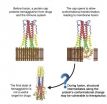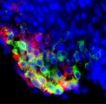(Press-News.org) HOUSTON – (July 31, 2014) – A flu virus acts like a Trojan horse as it attacks and infects host cells. Scientists at Rice University and Baylor College of Medicine have acquired a clearer view of the well-hidden mechanism involved.
Their computer simulations may lead to new strategies to stop influenza, perhaps even a one-size-fits-all vaccine.
The discovery detailed this week in the Proceedings of the National Academy of Science shows the path taken by hemagglutinin, a glycoprotein that rides the surface of the influenza virus, as it releases fusion peptides to invade a host cell.
The release mechanism has been the subject of many theories, but none have explained experimental observations as well as the new work led by biophysicist José Onuchic at Rice and biochemists Qinghua Wang at Baylor and Jianpeng Ma, who has a joint appointment at the two institutions.
The Rice-Baylor team applied protein-folding algorithms developed by Onuchic and his colleagues to analyze how hemagglutinin reconfigures itself as it infects a cell.
Hemagglutinin is completely folded at the start of the process of interest to researchers who study viral infection, Ma said. "It may be the only case known to human beings where a protein starts at a fixed point and literally completely refolds," he said.
Proteins are the molecular motors that spring from DNA and perform tasks essential to life, and they are the prime focus of study for Onuchic and his colleagues at Rice's Center for Theoretical Biological Physics (CTBP). The researchers use their energy landscape theory to determine the path an unfolded strand of amino acids takes as it collapses into a final, functional protein. That involves calculating the energetic preferences of every acid in the chain as well as the influence of the surrounding environment as folding progresses.
When Ma met Onuchic a few years ago, he recognized an opportunity. "I told him there's a very important feature of the viral system that would be ideal for his energy landscape approach." Ma said.
Researchers have long observed hemagglutinin's initial and final structures through X-ray crystallography. But because the change happens so quickly, it has been impossible to capture an image of the glycoprotein in transit. Ma said the key to stopping the flu could be to attack these intermediate structures.
Energy landscape theory predicts how a protein will fold no matter how fast it happens. In the case of hemagglutinin, the unfolding and refolding happens in seconds. During the process, part of the protein "cracks" and releases fusion peptides.
"The fusion peptides are the most important part of the molecule," said Rice postdoctoral researcher and co-author Jeffrey Noel. "The hemagglutinin is attached to the viral membrane, and when these peptides are released, they embed themselves in the target cell's membrane, creating a connection between the two."
"The purpose of hemagglutinin is to poke a hole between the two membranes," Ma said. "They have to fuse so the genetic material will be injected into the human cell."
Hemagglutinin is recognized by polysaccharide receptors on host cells and is absorbed when the cells engulf it. Initially, part of the protein forms a cap that protects the segments inside.
Acidic conditions cause the cap to fall off, and the protein begins to reconfigure itself. "The release of the fusion peptide, which is initially hidden inside hemagglutinin, is triggered by that giant conformational change," Ma said.
"When the cap is on, the whole protein is stable," Noel said. "What we see in the simulation is that the hydrophobic pocket where the fusion peptides are buried is very unstable and wants to crack as soon as the cap comes off."
By using the experimental structural information from X-ray crystallography to approximate the full energy landscape of hemagglutinin, the researchers can now capture a rough picture of the steps involved in its reconfiguration, including the point at which the peptides are released. "We now, for the first time, have mapped out the entire process, going from state A to state B, and the energetics along the way," Ma said.
Ma said frequent mutations to the cap help the virus avoid antibodies; this is the reason people need flu shots every year. But he suspects the inner part of the protein is more highly conserved. "We're targeting the part that the virus cannot afford to change. Therefore, it provides more hope for developing therapeutic agents," he said. Such agents could lead to a universal flu vaccine that would last a lifetime.
He said the membrane fusion mechanism is widely shared among many biological systems, which makes influenza a good model for studying other diseases. "HIV has one. Ebola has one. And it's also shared by intercell transport in the nervous system," Ma said.
He noted the work could not have been done without CTBP, which moved to Rice from the University of California, San Diego, three years ago to take advantage of collaborations with Texas Medical Center researchers – one of Rice's Priorities for the New Century. "This demonstrates a very interesting collaboration between TMC and Rice," Ma said. "We're very happy with that."
INFORMATION:
The paper's co-authors are Rice graduate students Xingcheng Lin and Nathanial Eddy, and Paul Whitford, an assistant professor at Northeastern University in Boston. Onuchic is Rice's Harry C. and Olga K. Wiess Professor of Physics and Astronomy and co-director of the CTBP based at Rice's BioScience Research Collaborative. Ma is a professor of bioengineering at Rice and the Lodwick T. Bolin Professor of Biochemistry at Baylor. Wang is an assistant professor of biochemistry and molecular biology at Baylor.
The National Science Foundation (NSF), the Welch Foundation, the National Institutes of Health, the Gillson-Longenbaugh Foundation and the Cancer Prevention Research Institute of Texas supported the research.
The researchers utilized the Data Analysis and Visualization Cyberinfrastructure (DAVinCI) supercomputer supported by the NSF and the BlueBioU supercomputer, both administered by Rice's Ken Kennedy Institute for Information Technology.
Read the abstract at http://www.pnas.org/content/early/2014/07/31/1412849111.abstract
This news release can be found online at http://news.rice.edu/2014/07/31/researchers-uncover-clues-to-flus-mechanisms/
Follow Rice News and Media Relations via Twitter @RiceUNews
Related Materials
José Onuchic: http://chemistry.rice.edu/FacultyDetail.aspx?p=51BE2F2C673C5991
Jianpeng Ma bio: http://bioengineering.rice.edu/faculty/Jianpeng_Ma.aspx
Qinghua Wang: https://www.bcm.edu/departments/biochemistry-and-molecular-biology/?PMID=8138
Structure-based Models for Biomolecules: http://smog-server.org
Images for download:
http://news.rice.edu/wp-content/uploads/2014/07/0804_FLU-1-web.jpg
The influenza hemagglutinin protein reconfigures itself as it targets host cells to infect them. Until new analysis by Rice University and Baylor College of Medicine researchers, nobody had been able to study the intermediate states of the protein-refolding process that may be vulnerable to treatment with drugs. (Credit: Jeffrey Noel/Rice University)
http://news.rice.edu/wp-content/uploads/2014/07/0804_FLU-2-web.jpg
The influenza hemagglutinin protein may take two paths as it reconfigures while attaching a virus to a host cell: It can send all its fusion peptides to the host or split them between the host and the virus. Researchers at Rice University and Baylor College of Medicine hope to identify a point during reconfiguration at which drugs could inactivate the peptides. (Credit: Nathanial Eddy/Rice University)
Located on a 300-acre forested campus in Houston, Rice University is consistently ranked among the nation's top 20 universities by U.S. News & World Report. Rice has highly respected schools of Architecture, Business, Continuing Studies, Engineering, Humanities, Music, Natural Sciences and Social Sciences and is home to the Baker Institute for Public Policy. With 3,920 undergraduates and 2,567 graduate students, Rice's undergraduate student-to-faculty ratio is just over 6-to-1. Its residential college system builds close-knit communities and lifelong friendships, just one reason why Rice has been ranked No. 1 for best quality of life multiple times by the Princeton Review and No. 2 for "best value" among private universities by Kiplinger's Personal Finance.
Researchers uncover clues to flu's mechanisms
Rice, Baylor scientists analyze how influenza-related proteins help infect cells
2014-07-31
ELSE PRESS RELEASES FROM THIS DATE:
UF study advances 'DNA revolution,' tells butterflies' evolutionary history
2014-07-31
GAINESVILLE, Fla. --- By tracing nearly 3,000 genes to the earliest common ancestor of butterflies and moths, University of Florida scientists have created an extensive "Tree of Lepidoptera" in the first study to use large-scale, next-generation DNA sequencing.
Among the study's more surprising findings: Butterflies are more closely related to small moths than to large ones, which completely changes scientists' understanding of how butterflies evolved. The study also found that some insects once classified as moths are actually butterflies, increasing the number of butterfly ...
NYU CDUHR researchers look at prescription opioid abuse among young adults in NYC
2014-07-31
The prevalence of heroin use has been rising steadily in the U.S in recent years. According to the National Survey on Drug Use and Health, the number of individuals reporting past year heroin use almost doubled between 2007 (373,000) and 2012 (669,000). Emerging evidence suggests the increase may be linked to prescription opioid (PO) users who transition from oral and/or intranasal PO use to heroin use, with POs providing the entryway to regular opioid use, and ultimately, heroin injection. This drug-use trajectory appears to have become increasingly common over the past ...
NYU research looks to combat US Latina immigrant obesity
2014-07-31
According to the U.S. Census Bureau, Latinos are the largest minority group in the United States, comprising 16.7% of the population. Approximately one-third of Latinos are obese and are 1.2 times as likely to be obese compared to non-Hispanic Whites.
NYU College of Nursing student researcher Lauren Gerchow, BSN, RN, MSN candidate, has sought to identify the factors that contribute to this problem by compiling a systematic review of qualitative studies that focused on food patterns in Latina women recently published in Nursing Research.
"The review focuses on women ...
Stanford professor finds that wildfires and other burns play bigger role in climate change
2014-07-31
It has long been known that biomass burning – burning forests to create agricultural lands, burning savannah as a ritual , slash-and-burn agriculture and wildfires – figures into both climate change and public health.
But until the release of a new study by Stanford University Civil and Environmental Engineering Professor Mark Z. Jacobson, the degree of that contribution had never been comprehensively quantified.
Jacobson's research, detailed in a paper published July 30 in the Journal of Geophysical Research: Atmospheres, is based on a three-dimensional computer model ...
Childhood coxsackie virus infection depletes cardiac stem cells and might compromise heart health in adults
2014-07-31
There is epidemiological evidence that links type B coxsackie virus (CVB) infection with heart disease, and research published on July 31st in PLOS Pathogens now suggests a mechanism by which early infection impairs the heart's ability to tolerate stress at later stages of life.
CVB infection is very common and affects mostly children. The symptoms range widely: over half of the infections are thought to be asymptomatic, the majority of children who get sick have only a mild fever, and a very small proportion get inflammation of the heart or brain. On the other hand, ...
Multidisciplinary study reveals big story of cultural migration
2014-07-31
Quantifying and transforming the history of culture into visual representation isn't easy. There are thousands of individual stories across millennia to consider, and some historical conditions are nearly impossible to measure.
Addressing this challenge, Dr. Maximilian Schich, associate professor of arts and technology at The University of Texas at Dallas, has brought together a team of network and complexity scientists to create and quantify a big picture of European and North American cultural history.
Schich, an art historian who works under the umbrella of the ...
Shrinking dinosaurs evolved into flying birds
2014-07-31
VIDEO:
This movie is an animated version of how birds arose from a very special lineage of evolving dinosaurs.
Click here for more information.
A new study involving scientists from the University of Southampton has revealed how massive, meat-eating, ground-dwelling dinosaurs evolved into agile flying birds: they just kept shrinking and shrinking, for over 50 million years.
Today, in the journal Science, the researchers present a detailed family tree of dinosaurs and their ...
Innovative 'genotype first' approach uncovers protective factor for heart disease
2014-07-31
Cambridge, MA. Thurs. July 31, 2014 — Extensive sequencing of DNA from thousands of individuals in Finland has unearthed scores of mutations that destroy gene function and are found at unusually high frequencies. Among these are two mutations in a gene called LPA that may reduce a person's risk of heart disease. These findings are an exciting proof-of-concept for a new "genotype first" approach to identifying rare genetic variants associated with, or protecting from, disease followed by extensive medical review of carriers. The new study by researchers from the Broad Institute, ...
A mathematical theory proposed by Alan Turing in 1952 can explain the formation of fingers
2014-07-31
Alan Turing, the British mathematician (1912-1954), is famous for a number of breakthroughs, which altered the course of the 20th century. In 1936 he published a paper, which laid the foundation of computer science, providing the first formal concept of a computer algorithm. He next played a pivotal role in the Second World War, designing the machines which cracked the German military codes, enabling the Allies to defeat the Nazis in several crucial battles. And in the late 1940's he turned his attention to artificial intelligence and proposed a challenge, now called the ...
Nanostructured metal-oxide catalyst efficiently converts CO2 to methanol
2014-07-31
UPTON, NY-Scientists at the U.S. Department of Energy's (DOE) Brookhaven National Laboratory have discovered a new catalytic system for converting carbon dioxide (CO2) to methanol-a key commodity used to create a wide range of industrial chemicals and fuels. With significantly higher activity than other catalysts now in use, the new system could make it easier to get normally unreactive CO2 to participate in these reactions.
"Developing an effective catalyst for synthesizing methanol from CO2 could greatly expand the use of this abundant gas as an economical feedstock," ...
LAST 30 PRESS RELEASES:
Q&A: UW research shows neural connection between learning a second language and learning to code
Keane wins 2024 Gopal K. Shenoy Excellence in Beamline Science Award
Livestock abortion surveillance could protect livelihoods and detect emerging global pathogens
Optimal timing maximises Paxlovid benefits for treating COVID-19
IU researchers receive $4.8 million grant to study the role of misfolded protein TDP-43 in neurodegenerative diseases
DOE’s Office of Science Graduate Student Research Program selects 86 outstanding US graduate students
This tiny chip can safeguard user data while enabling efficient computing on a smartphone
World’s chocolate supply threatened by devastating virus
Wake up and die: Human brain neurons re-entering the cell cycle age quickly shift to senescence
Phage therapy is being explored to treat multidrug-resistant bacterial infections, but what are the direct effects of phages on the human host?
Social media use linked to tobacco initiation among youth
Marginalized communities developed 'disaster subculture' when living through extreme climate events, study finds
AGS honors Dr. William Hall with prestigious Nascher/Manning Award in Geriatrics
Human Frontier Science Program: life science research addressing sustainability of living systems
Wind turbine blades get a sustainable upgrade
New study uncovers lasting financial hardship associated with cancer diagnosis for working-age adults in the U.S.
The coupling between healthspan and lifespan in Caenorhabditis depends on…
2 USC faculty members named 2024 Guggenheim Fellows
4 USC faculty members named as fellows of prestigious science organization AAAS
Innovative microscopy demystifies metabolism of Alzheimer’s
Toward unification of turbulence framework – weak-to-strong transition discovered in turbulence
Innovative GREENSKY model elevates UAV efficiency in next-gen wireless networks
Majority of acute care hospitals do not admit representative proportion of Black Medicare patients in their local market
Smoking cessation before laryngeal cancer treatment improves survival, retention of voice box, study shows
Major milestone reached for key weapons component
PCORI announces $150 million in funding for new health research
Infected: understanding the spread of behavior
UNC-Chapel Hill researchers create artificial cells that act like living cells
New research develops forest extent map for Mexico
In the brain, bursts of beta rhythms implement cognitive control
[Press-News.org] Researchers uncover clues to flu's mechanismsRice, Baylor scientists analyze how influenza-related proteins help infect cells






